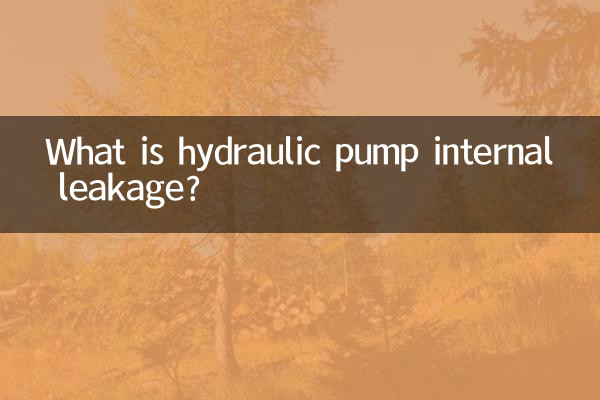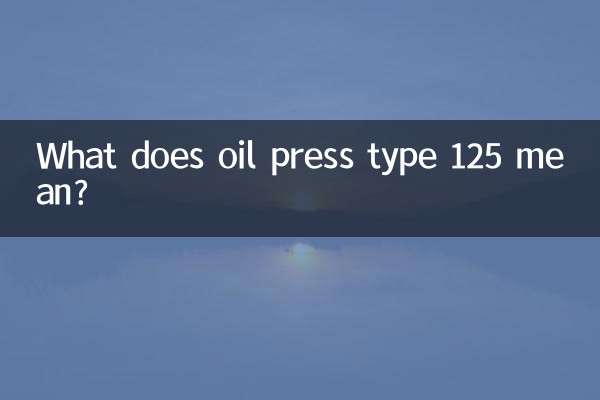What is hydraulic pump internal leakage?
Internal leakage of a hydraulic pump refers to the phenomenon that high-pressure oil leaks from the high-pressure chamber of the pump to the low-pressure chamber or to the outside due to internal seal failure or component wear during the working process of the hydraulic pump. This phenomenon will reduce the working efficiency of the hydraulic system, increase energy consumption, and even affect the normal operation of the equipment. This article will introduce in detail the causes, manifestations, detection methods and solutions of hydraulic pump internal leakage.
1. Reasons for internal leakage of hydraulic pump

Internal leakage of hydraulic pumps is usually caused by the following reasons:
| reason | Detailed description |
|---|---|
| Seals are aged or damaged | The seals of hydraulic pumps will age, crack or deform after long-term use, leading to seal failure. |
| Part wear | Key components such as the pump's rotor, blades or gears are worn due to long-term friction, and the gaps increase, causing internal leakage. |
| oil contamination | Impurities or particles mixed into the oil can aggravate the wear of seals and components, leading to leakage. |
| Improper assembly | During the maintenance or assembly process of the pump, the seals are not installed in place or tightened firmly, causing internal leakage. |
2. Performance of internal leakage of hydraulic pump
Hydraulic pump internal leakage usually presents with the following symptoms:
| Performance | Detailed description |
|---|---|
| Output flow decreases | The output flow of the pump is significantly reduced, causing the actuator to move slowly or weakly. |
| pressure fluctuations | The system pressure is unstable, fluctuates frequently or cannot reach the set value. |
| Oil temperature rises | Internal leakage will cause energy loss, which is converted into heat, causing the oil temperature to rise abnormally. |
| Increased noise | The noise increases significantly when the pump is running, especially in the high-pressure area. |
3. Detection method of internal leakage of hydraulic pump
The following are common methods for detecting internal leakage of hydraulic pumps:
| Detection method | Specific operations |
|---|---|
| Traffic test | Use a flow meter to measure the output flow of the pump and compare it with the rated value to determine whether there is internal leakage. |
| stress test | Monitor the system pressure through a pressure gauge to see if the pressure is stable or reaches the set value. |
| temperature monitoring | Use an infrared thermometer to detect the temperature of the pump body. Abnormal temperature rise may be a signal of internal leakage. |
| Noise analysis | Analyze the noise of the pump through a listening stick or professional equipment to determine internal wear and tear. |
4. Solutions for internal leakage of hydraulic pumps
To solve the problem of internal leakage of the hydraulic pump, the following measures can be taken:
| solution | Specific measures |
|---|---|
| Replace seals | Regularly inspect and replace aging or damaged seals to ensure sealing performance. |
| Repair or replace worn parts | Repair or replace severely worn rotors, blades or gears. |
| Keep oil clean | Filter or replace hydraulic oil regularly to avoid contamination by impurities. |
| Standardize assembly process | Assemble the hydraulic pump in strict accordance with standard procedures and ensure that the seals are installed in place. |
5. Summary
Internal leakage of hydraulic pumps is a common problem in hydraulic systems, mainly caused by seal failure, component wear, oil contamination or improper assembly. It manifests itself as flow rate decrease, pressure fluctuation, oil temperature increase and noise increase. Internal leakage problems can be detected through methods such as flow testing, pressure testing, temperature monitoring and noise analysis. Solutions include replacing seals, repairing worn parts, keeping oil clean and standardizing assembly processes. Regular maintenance and inspections are key to preventing internal leakage in hydraulic pumps.
I hope this article can help you better understand the problem of internal leakage of hydraulic pumps and provide a reference for practical work.

check the details

check the details